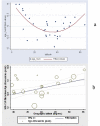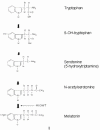Association between adolescent idiopathic scoliosis prevalence and age at menarche in different geographic latitudes
- PMID: 16759371
- PMCID: PMC1501058
- DOI: 10.1186/1748-7161-1-9
Association between adolescent idiopathic scoliosis prevalence and age at menarche in different geographic latitudes
Abstract
Background: Age at menarche is considered a reliable prognostic factor for idiopathic scoliosis and varies in different geographic latitudes. Adolescent idiopathic scoliosis prevalence has also been reported to be different in various latitudes and demonstrates higher values in northern countries. A study on epidemiological reports from the literature was conducted to investigate a possible association between prevalence of adolescent idiopathic scoliosis and age at menarche among normal girls in various geographic latitudes. An attempt is also made to implicate a possible role of melatonin in the above association.
Material-methods: 20 peer-reviewed published papers reporting adolescent idiopathic scoliosis prevalence and 33 peer-reviewed papers reporting age at menarche in normal girls from most geographic areas of the northern hemisphere were retrieved from the literature. The geographic latitude of each centre where a particular study was originated was documented. The statistical analysis included regression of the adolescent idiopathic scoliosis prevalence and age at menarche by latitude.
Results: The regression of prevalence of adolescent idiopathic scoliosis and age at menarche by latitude is statistically significant (p < 0.001) and are following a parallel declining course of their regression curves, especially in latitudes northern than 25 degrees.
Conclusion: Late age at menarche is parallel with higher prevalence of adolescent idiopathic scoliosis. Pubarche appears later in girls that live in northern latitudes and thus prolongs the period of spine vulnerability while other pre-existing or aetiological factors are contributing to the development of adolescent idiopathic scoliosis. A possible role of geography in the pathogenesis of idiopathic scoliosis is discussed, as it appears that latitude which differentiates the sunlight influences melatonin secretion and modifies age at menarche, which is associated to the prevalence of idiopathic scoliosis.
Figures



References
-
- Nissinen M, Heliovaara M, Ylikoski M, Poussa M. Trunk asymmetry and screening for scoliosis: a longitudinal cohort study of pubertal schoolchildren. Acta Paediatr. 1993;82:77–82. - PubMed
-
- Willner S, Uden A. A prospective prevalence study of scoliosis in Southern Sweden. Acta Orthop Scand. 1982;53:233–7. - PubMed
-
- Laulund T, Sojbjerg JO, Horlyck E. Moire topography in school screening for structural scoliosis. Acta Orthop Scand. 1982;53:765–8. - PubMed
-
- Burwell RG, James NJ, Johnson F, Webb JK, Wilson YG. Standardised trunk asymmetry scores. A study of back contour in healthy school children. J Bone Joint Surg Br. 1983;65:452–63. - PubMed
LinkOut - more resources
Full Text Sources

